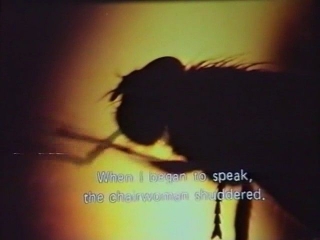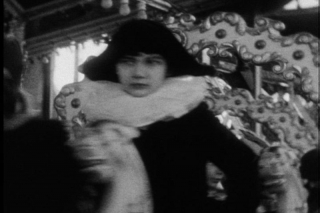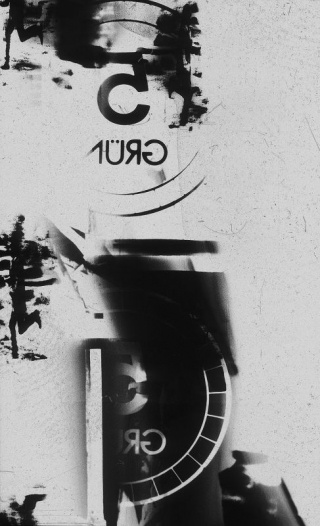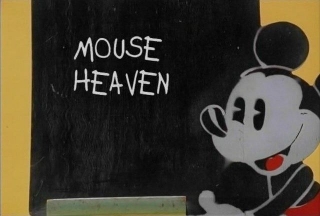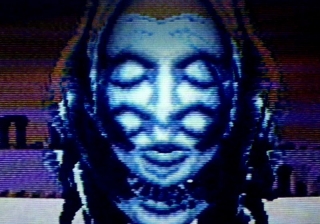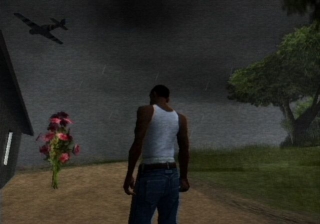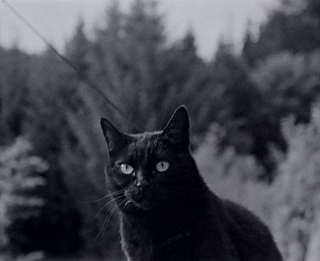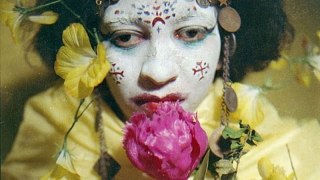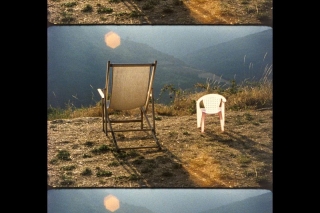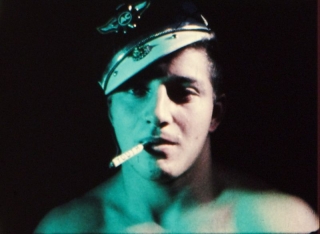Date: 30 October 2005 | Season: London Film Festival 2005 | Tags: London Film Festival
FILMS BY VLADIMIR TYULKIN
Sunday 30 October 2005, at 2pm
London National Film Theatre NFT3
Vladimir Tyulkin, About Love, Kazakhstan, 2005, 28 min
A portrait of Nina Perebeyeva, who for 30 years has dedicated her life to abandoned and infirm dogs, turning her home into Kazakhstan’s only animal shelter. Dogs are everywhere – constantly barking and bickering – and the house is one big litter tray, but there is such compassion in the chaos. Perebeyeva is almost saintly in her devotion to the animals, and the film’s tender view culminates in the absolute wonder of its life-affirming ending, in which she receives an unexpected gift from the film crew.
Vladimir Tyulkin, Lord of the Flies, Kazakhstan, 1990, 45 min
Lord of the Flies is an incredible glimpse into the life of Kirill Ignatyevich Schpak and his garden of unearthly delights. An outsider by any standards, Grandad Kirill has spent his retirement ‘undermining the fly population’ by killing flies with an almost religious fervour, hoping to prevent contamination by the bacteria they carry. Hard working and well intentioned, his method is inventive but slightly skew. It looks like he’s actually cultivating larvae in his ‘flytrone’ just so that he can destroy it, after which it’s preserved as feed for the chickens. ‘It gives me free meat and eggs. If such farms are set up all over the country, we’ll enter a new era of prosperity’. He admits his efforts are futile unless his pest control plan is implemented worldwide, and his self-sufficiency doesn’t entirely provide for his citizens: he buys canine corpses from the dogcatcher and boils up the meat – disguising the taste with stewed aubergines – to feed to his hounds. This self-styled tsar enforces strict law and order and has no time for perestroika; his backyard is a ‘state in miniature’ in which nations of animals live in communal harmony. Kirill addresses the camera with crazy schemes and proclamations, and the camera spins off into inspired observations of the world he has created. The visionary cinematography and autumnal colours make the film look like an apparition from Hieronymus Bosch, perfectly apt for this extreme, medieval lifestyle.
PROGRAMME NOTES
FILMS BY VLADIMIR TYULKIN
Sunday 30 October 2005, at 2pm
London National Film Theatre NFT3
ABOUT LOVE
Vladimir Tyulkin, Kazakhstan, 2005, video, colour, sound, 28 min
A portrait of Nina Perebeyeva, who for 30 years has dedicated her life to abandoned and infirm dogs, turning her home into Kazakhstan’s first and only animal shelter. Dogs are everywhere – constantly barking and bickering – and the house is one big litter tray, but there is such compassion in the chaos. Perebeyeva graduated from the conservatoire, but her piano has long been abandoned. She now sings in the church choir and is almost saintly in her devotion to the animals, taking care of between 50 to 120 dogs on a small salary of 40 dollars. This tender film culminates in the absolute wonder of its life-affirming ending, in which she receives an unexpected gift from the film crew. (Mark Webber)
LORD OF THE FLIES
Vladimir Tyulkin, Kazakhstan, 1990, 35mm, colour, sound, 45 min
Vladimir Tyulkin’s 42-minute epic documentary Lord of the Flies introduced Kirill Ignatjewich Spack, a wild-haired post-Soviet farm hermit who’d developed a complete self-sustaining animal ecosystem involving the farming of flies to produce maggot-feed for his animals, who one by one became the meat traps to lure in the flies. A Russian tyrant in miniature – the Stalin of his bestial gulag – he talked Tyulkin calmly through his mad methods and morals, and commended his system to Mikhail Gorbachev for national rollout. This animal kingdom seemed to have regressed to the Hobbesian idea of the state of nature: nasty, brutish and short. (Nick Bradshaw)
Lord of the Flies belongs to the literary tradition of Jules Vernes’ tale ‘Two Years Holidays’, in which he describes schoolboys who bring into being a rationality-based, ideal world after being stranded from a shipwreck. William Golding’s story, ‘Lord of the Flies’ from 1954 takes up the motif of the stranded children, but sketches far more realistically, the development of despotism in miniature format. The figure of the fly killer in Tyulkin’s film possesses many aspects: as the post-communist version of the hippie dropout, he symbolises the improvised gardening at a datscha, a way in which many Soviet citizens ensured their survival after perestroika at a primitive level. He sways back and forth between the caricature of new entrepreneurship – after all, he has managed to construct an own economic circulation on his land – and the incarnation of the last Stalinists, who are still obsessed with ridding the world of their enemies. Flies have, furthermore, a long tradition in Soviet iconography: their larvae in canteen meat are the trigger of the revolution in Battleship Potemkin, symbolic of the rotten system of the Czar, a metaphor for the later, no less degenerated Soviet system, described in the works of Ilya Kabakov. At the same time flies have always been seen as a worthless life form because of the sheer masses in which they appear and because of their short lifespan, which refers to the Gulag in its purposeful annihilation, but also refers to their ideal disposition as material for scientific experiments, just as the Soviet person in the socialist experiment. The film achieves a particular topicality not only due to the war in Chechnya with its undisguised purge terminology, but also of genetic technology, which began with flies and is now being advanced to human beings. (Craig Venter is, since his decoding of the Drosophila Genome also termed “the Lord of the Flies”.) And, it is actually so, that the notion of the New Human Being is enjoying its resurrection through genetic technology. (Marcel Schwierin)
Back to top
Date: 30 October 2005 | Season: London Film Festival 2005 | Tags: London Film Festival
HISTORY AS SHE IS HARPED
Sunday 30 October 2005, at 4pm
London National Film Theatre NFT3
Leslie Thornton, Let Me Count The Ways: Minus 10, 9, 8, 7, USA, 2004, 20 min
A meditation on the bombing of Hiroshima, matching found footage with revealing audio interviews with survivors, and informed by the film-maker’s personal connection to the horrific event. It opens with amateur movies of Thornton’s father (a nuclear physicist who worked on the Manhattan Project) at the Los Alamos Air Base. Later sections concern the effects on vegetation in the devastated region.
Jayne Parker, Stationary Music, UK, 2005, 15 min
Poetic record of ‘Sonata 1’ (1925) by modernist composer Stefan Wolpe – a Jewish communist who was forced to flee Germany in 1933, ultimately making the transition from the Bauhaus to Black Mountain College. An appropriately still and empathetic camera captures this vibrant solo piano performance by his daughter Katerina, who first recounts some of the history of the piece.
Abigail Child, The Future Is Behind You, USA, 2004, 16 min
Fictional biography woven around home movie footage shot by an anonymous German family in the 1930s. The relationship of two adolescent sisters, and how it may have been affected by the turbulent times ahead, is the focus of a work that raises questions about the interpretation of personal and public histories.
Deborah Stratman, Energy Country, USA, 2003, 15 min
Stratman’s impressionistic essay on the oil industry implicitly refers to ulterior motives behind the invasion of Iraq. The dreamlike tour of petrochemical sites in Southern Texas contrasts with the harsh realities of Christian fundamentalist attitudes to homeland security that are heard on the soundtrack.
Fréderic Moser & Philippe Schwinger, Capitulation Project, Germany-Switzerland, 2003, 21 min
What at first looks to be historical footage of the Performance Group’s ‘Commune’ (1971) – a stark work of environmental theatre about the My Lai massacre – is in fact a carefully re-staged interpretation featuring German actors. Its apparent authenticity, which reflects the Group’s constant shifting between performance, improvisation and rehearsal, oscillates the viewer’s concentration between the various levels of reality it presents.
PROGRAMME NOTES
LET ME COUNT THE WAYS: MINUS 10, 9, 8, 7
Leslie Thornton, USA, 2004, video, b/w, sound, 20 min
Let Me Count the Ways is an ongoing serial about violent terror and its aftermath. In episodes Minus 10, 9, 8, and 7, personal reminiscence is mixed with archival and new footage in an exploration of the interior of fear. From footage of the artist’s father on the way to Hiroshima, through reference to 9/11, the phenomenology of horror and the echo of its rupture are presented with an intensity which moves the viewer from history to the present and beyond. (Leslie Thornton)
STATIONARY MUSIC
Jayne Parker, UK, 2005, video, b/w, sound, 15 min
Stationary Music takes its name from the first movement of Stefan Wolpe’s ‘Sonata 1’ composed in 1925. The sonata is introduced and performed by his daughter, pianist Katharina Wolpe. Stationary Music: music that doesn’t develop/music that stands still.
(Jayne Parker)
after the fire what Shall we do?
“firsT
onE step;
aFter
thAt,
aNother.”
We’re
alOne
the music is difficuLt
to Play.
wE must work at it.
In Memoriam S. W., acrostic by John Cage
THE FUTURE IS BEHIND YOU
Abigail Child, USA, 2004, video, b/w, sound, 16 min
Music by John Zorn, arranged and played by Sylvie Courvoisier and Mark Feldman. The Future is Behind You creates a fictional story composed from an anonymous family archive from 1930s Europe, reconstructed to emphasize gender acculturation in two sisters who play, race, fight, kiss and grow up together under a shadow of oncoming history. I am looking, as always in found material, for the story below the story. Here there are at least three levels: 1) the home movie in which a family from 1930s Germany near the Swiss border poses for the camera, preternaturally happy. Unusually, the mother is main cinematographer; 2) the historical moment which remains as text trace, undermining the image and serving as covert motive for the action; 3) the development of gender identities – the innocent freedom of the elder transformed into socially bruised ‘bride’, the irrepressibility of the younger moving from tomboy to awkward, diffident adult. At once biography and fiction, history and psychology, The Future is Behind You excavates gestures to explore the speculative seduction of narrative; it seeks a bridge between private and public histories. (Abigail Child)
www.abigailchild.com
ENERGY COUNTRY
Deborah Stratman, USA, 2003, video, colour, sound, 15 min
The frenzied detritus of trading floors, smart weaponry and the religious right are woven through the petrochemical landscapes of Southeast Texas. This short video harangue questions land use policy as it serves the oil industry, patriotism as it absolves foreign aggression, and fundamentalism as it calcifies thinking. (Deborah Stratman)
www.pythagorasfilm.com
CAPITULATION PROJECT
Frédéric Moser & Philippe Schwinger, Germany-Switzerland, 2003, video, b/w, sound, 21 min
The New York-based Performance Group staged their piece ‘Commune’ for the first time in February 1971. The play included a short scene referring to the My Lai massacre. If members of the audience refused to participate actively in what was happening on stage during this scene, the actors interrupted their performance – sometimes for as long as three hours, depending on the audience’s reaction. The group experimented with several variations of the scene. Starting with photographs of the performance and the notes of Richard Schechner, the theorist of environmental theatre, we came up with a new version of the My Lai sequence. We worked with the statements of soldiers involved in the massacre, criminal investigation reports, and contemporary articles in the press. In the process, we developed a scenario that enabled us to translate the historical documents into a form suitable for the stage. We aimed at representing an event of war without using any of the film industry’s spectacular devices. What means do we have, as individual citizens, to come to terms with an act of terror? We followed the trail of the Performance Group. Their attempt to create a platform for self-criticism within the context of a theatre performance motivated our dramatic intentions. For this we reconstructed the stage set of ‘Commune’: a wave, evoking a landscape and also functioning as an agora, and scaffolding around the stage with seating for the audience. In 1971 the performers were inspired by rituals: they danced and they sang. We did not attempt to re-create this authenticity in our production. Although we do evoke the symbolic level of their representation, we chose to develop our play with the actors on two different levels. Each of the performers takes on a function, for example, as a reporter, but they can also intervene at any time in their own name. Thus, there is a constant back and forth between the actors and the characters they are representing. This method of dramatic framing enabled us to establish an analogy with film. There is no live performance in Capitulation Project. The scene was filmed in about 30 sequences during two night shoots, with extras as a ‘fake’ audience. The distance from the performance that is created through the process of filming is comparable to our detachment from current political events. We intentionally moved back a few steps in time. We evoked the massacre by means of a contemporaneous artistic form in order to demonstrate that the grasp of an event of war is coupled with its transmission. (Frédéric Moser and Philippe Schwinger)
Back to top
Date: 30 October 2005 | Season: London Film Festival 2005 | Tags: London Film Festival
THE HEART OF THE MATTER
Sunday 30 October 2005, at 9pm
London National Film Theatre NFT3
Karen Mirza & Brad Butler, The Space Between, UK, 2005, 12 min
Time and space shattered into shards of light. Footage shot in India and thoroughly reworked in the optical printer into a rigorous, flickering duality.
Peter Tscherkassky, Instructions for a Light and Sound Machine, Austria, 2005, 17 min
Torment on the editing table: a Hollywood western persecuted by the brutal mechanics of the cinematic. A ruthless duel between character and conduit, played out to the death.
Daïchi Saïto, Chasmic Dance, Canada, 2004, 6 min
An expression of primal rhythmic energy that synthesises high-contrast film stock with exaggerated video raster lines.
Fred Worden, Blue Pole(s), USA, 2005, 20 min
Worden finds a digital outlet for the research into visual phenomena pursued in his films, creating one of the most startling abstract works of recent years. Video signal as constellation of light, piercing a cosmos of noetic possibilities. Its soundtrack is the equally mesmerising ‘London Fix’ by Tom Hamilton, an electronic composition based on the fluctuating price of gold. This strange brew is visual voodoo of the highest order.
Michael Robinson, You Don’t Bring Me Flowers, USA, 2005, 8 min
Powerful ecological omen composed of centrefold landscapes from National Geographic magazine. The seam down the centre of the images suggests the fractures caused by our reckless treatment of the planet.
Trish van Huesen, Fugue, USA, 2004, 7 min
‘Inspired by musical and psychological definitions, Fugue examines the dark flight from identity and environment. Hand processing and the juxtaposition of positive and negative footage depict the journey of a woman as she shifts between being black or white widow or bride.’ (TvH)
PROGRAMME NOTES
THE HEART OF THE MATTER
Sunday 30 October 2005, at 9pm
London National Film Theatre NFT3
THE SPACE BETWEEN
Karen Mirza & Brad Butler, UK, 2005, 16mm, colour, silent, 12 min
The Space Between tackles the context of the recycled image. Exploring the space between frames and within frames, conventional photographic representation gradually metamorphoses into abstract patterns of pulsing coloured light. What begins as an image of looking at (and through) a high-rise building offers viewers an opportunity to experience shifting relationships between perception and cognition, from realism to painterly abstraction. (Karen Mirza & Brad Butler)
www.mirza-butler.net
INSTRUCTIONS FOR A LIGHT AND SOUND MACHINE
Peter Tscherkassky, Austria, 2005, 35mm, b/w, sound, 17 min
The hero of Instructions for a Light and Sound Machine is easy to identify. Walking down the street unknowingly, he suddenly realizes that he is not only subject to the gruesome moods of several spectators but also at the mercy of the filmmaker. He defends himself heroically, but is condemned to the gallows, where he dies a filmic death through a tearing of the film itself. Our hero then descends into Hades, the realm of shadows. Here, in the underground of cinematography, he encounters innumerable printing instructions, the means whereby the existence of every filmic image is made possible. In other words, our hero encounters the conditions of his own possibility, the conditions of his very existence as a filmic shadow. Instructions for a Light and Sound Machine is an attempt to transform a Roman Western into a Greek tragedy. (Peter Tscherkassky)
www.tscherkassky.at
CHASMIC DANCE
Daïchi Saïto, Canada 2004, 16mm, b/w, silent, 6 min
A visual metaphor for the creative process as a sustained state of flux, whereby the deconstruction and reconfiguration of source material manifest themselves as a series of rapid abstract movements. Alluding to the cosmic dance of Shiva, the film is an expression of primal rhythmic energy, moving dialectically but without sublimation. Regeneration ignites destruction, and transformation invites mutation, through clashes of opposing modes such as video/film, surface/depth, and light/darkness. The original materials used in the film were images of the human body shot on 16mm film; they were modified through accidental processes in video transfer, and the resulting images were re-filmed back on 16mm, passing through multiple stages of printing on a modified Steenbeck. The film was hand-processed, optically printed and contact printed by the filmmaker. (Daichi Saito)
BLUE POLE(S)
Fred Worden, USA, 2005, video, colour, sound, 20 min
For 25 years I’ve been interested in an optical/perceptual cinema. A cinema where the eye is called out from its routine and autonomic operations and is challenged to make sense of stimuli coming not from the natural world out in front of the eyes, but rather from a source behind the eyes, the conscious mind. A kind of feedback loop in which the conscious mind employs the seductive powers of cinema to seed the perceptual mind with curiosity and imagination, qualities not native to perception. Blue Pole(s) tries hard to up the ante on the notion that film is a visual rather than literary art and that seeing as a perceptual process precedes and models thought. Music by Tom Hamilton. (Fred Worden)
YOU DON’T BRING ME FLOWERS
Michael Robinson, USA, 2005, 16mm, colour, sound, 8 min
Viewed at its seams, a collection of National Geographic landscapes from the 1960s and 1970s conjure an extinct American romanticism currently peddled to propagate entitlement and bigoted individualism from sea to shining sea; the slideshow deforms into a bright white distress signal. (Michael Robinson)
www.poisonberries.net
FUGUE
Trish van Huesen, USA, 2004, 16mm, colour, sound, 7 min
This film, as with all of my work, is an exploration of change. It was a difficult film for me to make. I was living in the United States, and all of the horror, fear and nationalistic fanaticism after September 11th began to permeate my consciousness. The heroine of the film, as she began her descent, started to look as much like the image of a country as the image of a human being. During the editing process, as America dropped bombs on Iraq, I could not seem to get her out of “hell”, and then suddenly, just as a thunder storm strikes and then passes, the darkness broke and she ascended again. It was the collaboration with my partner in sound, Eyvind Kang, and his co-creators, which actually broke the darkness and facilitated her ascension. We were all affected by what was happening in America, but I was creating from the darkness, and they were more able to create from the light. Eyvind’s choice of ‘Emblem 50’ of Michael Maier’s fugal works, as a starting point for the soundtrack, woke me up to the reality out of which I had been creating. The result is a black and white film which examines Darkness as the partner of Light. (Trish Van Huesen)
Back to top
Date: 1 April 2006 | Season: London Film Festival 2005 | Tags: London Film Festival
LONDON FILM FESTIVAL EXPERIMENTA TOUR 2006
April–June 2006
UK touring programme
The Experimenta tour presents a selection of artists’ film and video from The Times bfi London Film Festival 2005. It features established and emerging international artists, encompassing documentary, animation, performance, personal and political works.
This year’s package contains two mixed programmes devoted to recent short films and videos, documentaries about extraordinary relationships between humans and animals, and James Benning’s stunning Ten Skies, “the cinematic equivalent of the delirious process of lying on one’s back staring at the sky and letting one’s head clear into a near meditative state.”
Experimenta has created a space in the Festival for the most innovative forms of cinema, presented on an even platform with premieres of independent features and blockbuster movies. It provides a focus point for artists’ moving image and non-narrative filmmaking, bringing together works from around the world in a sequence of curated screenings. Experimenta promotes works that exist equally in film and art contexts, those that open up new ways of seeing, and of thinking.
TEN SKIES
James Benning, Ten Skies, USA, 2004, 133 min
FILMS BY VLADIMIR TYULKIN
Vladimir Tyulkin, About Love, Kazakhstan, 2005, 28 min
Vladimir Tyulkin, Lord of the Flies, Kazakhstan, 1990, 45 min
FILM FOCUS
David Gatten, The Great Art of Knowing, USA, 2004, 37 min
Janie Geiser, Terrace 49, USA, 2004, 6 min
Lewis Klahr, The Two Minutes to Zero Trilogy, USA, 2003-04, 33 min
Karen Mirza & Brad Butler, The Space Between, UK, 2005, 12 min
Michael Robinson, You Don’t Bring Me Flowers, USA, 2005, 8 min
Trish van Huesen, Fugue, USA, 2004, 7 min
VIDEO VISIONS
Leslie Thornton, Let Me Count The Ways: Minus 10, 9, 8, 7, USA, 2004, 20 min
Jayne Parker, Stationary Music, UK, 2005, 15 min
Jacqueline Goss, How to Fix the World, USA-Uzbekistan, 2004, 28 min
Guy Ben-Ner, Wild Boy, Israel-USA, 2004, 17 min
Kenneth Anger, Mouse Heaven, USA, 2005, 10 min
Selections from these programmes screened at Belfast Queens Film Theatre, Bristol Arnolfini, Edinburgh Filmhouse, Leeds Hyde Park Picture House, London Greenwich Picturehouse, London ICA and Sheffield Showroom.
Date: 28 October 2006 | Season: London Film Festival 2006 | Tags: London Film Festival
THE TIMES BFI 50th LONDON FILM FESTIVAL
Saturday 28 – Monday 30 October 2006
London National Film Theatre
The Times BFI London Film Festival presents its fourth annual Experimenta Avant-Garde Weekend, featuring a concentrated, international programme of artists’ film and video. This is a unique opportunity to survey some of the most original and vital work by international artists, presenting a diversity of observations, personal statements and technical innovation. We anticipate that many film-makers will be in attendance to introduce and discuss their work.
In this anniversary year, we will celebrate the work of Jack Smith and special guest Kenneth Anger, both influential pioneers distinguished for their creative vision and lack of compromise. Four curated programmes of recent film and videos present the most innovative international work. Taking ‘old media’ outside the architecture of the cinema, Luis Recoder and Sandra Gibson will perform a live multi-projection work at the ICA to close the weekend on Monday evening.
Other festival highlights include folk art films made by Phil Chambliss in the Arkansas outback, plus screenings of recently restored prints of Alejandro Jodorowsky’s Holy Mountain and Vittorio de Seta’s glorious documentary shorts.
Date: 28 October 2006 | Season: London Film Festival 2006 | Tags: London Film Festival
GAMES PEOPLE PLAY
Saturday 28 October 2006, at 2pm
London National Film Theatre NFT3
Miranda Pennell, You Made Me Love You, UK, 2005, 4 min
‘Twenty-one dancers are held by your gaze. Losing contact can be traumatic.’
Shannon Plumb, Olympics 2005 Track and Field, USA, 2005, 18 min
From the opening ceremony to awarding the medals, Plumb plays all the characters in this burlesque of the trials and triumphs of the summer games. Rooted in silent comedy, its homespun style references equal parts Keaton and Riefenstahl, and is the vehicle for a series of witty observations.
Victor Alimpiev, Sweet Nightingale, Russia, 2005, 7 min
In a theatre, a crowd perform a series of choreographed gestures facing the stage. Left unexplained, this mysterious ceremony appears more symbolic than absurd.
Judith Hopf, Nayascha Sadr Haghighian & Florian Zeyfang, Proprio Aperto, Germany, 2005, 6 min
An off-season stroll through the temporary ruins of the Giardini, home of the national pavilions at the Venice Biennale.
Phil Solomon & Mark Lapore, Untitled (for David Gatten), USA, 2005, 5 min
Made as a ‘get well card’ for a friend, this uncharacteristic work invokes a sense of absence, and ultimately loss.
Pablo Marin, Blocking, Argentina, 2005, 3 min
By contravening archival guidelines on water damage, the original image is erased from a ‘mistreated’ filmstrip, to be replaced by an organic explosion of colour.
Matthias Müller & Christophe Girardet, Kristall, Germany, 2006, 15 min
Shards of emotions from Hollywood melodrama are combined in a Chinese box of reflection and refraction. Kristall is a cinematic hall of mirrors, which ruptures and multiplies the anxieties of narcissistic, star-crossed lovers.
Angela Reginato, Contemplando la ciudad, USA, 2005, 4 min
‘Perfectly without affect, a girl sings along with a pop tune, transporting herself through space and time to Mexico City circa 1978.’
PROGRAMME NOTES
GAMES PEOPLE PLAY
Saturday 28 October 2006, at 2pm
London National Film Theatre NFT3
YOU MADE ME LOVE YOU
Miranda Pennell, UK, 2005, video, colour, sound, 4 min
You Made Me Love You, Pennell’s last film to date, is based on a sort of exercise, a game, in which a cameraman portrays 21 male and female dancers. They are asked to form a queue facing the camera (a very English idea). As with a stationary queue in which people start getting restless, those at the back try to gain a view of the counter, i.e. camera. But the picture is mostly filled by the four or five faces that are nearest to the camera, which block the view of the others. However, the camera does not allow the situation to settle; mounted on rails, it moves, sometimes slowly, then very rapidly, and always surprisingly, to the left or the right. The queue has to follow, which means that the faces that have just filled the picture suddenly disappear, allowing the deeper levels of staging, the dancers who are further away, to be seen. This video is thus shaped by a ‘constant line’, a rigid concept which, through its realisation, creates a lot of movement, overlapping, and surprising revelations. Meanwhile, within the sound track, moments of tense calm alternate with the patter of many bare feet, a noise that is all the more confusing because we never see the feet in the picture. What these 3½ minutes allow us to see instead is a wealth of strangely touching portraits: 21 people ‘making love to the camera’. (Dirk Schaefer, Oberhausen Festival)
www.mirandapennell.com
OLYMPICS 2005 TRACK AND FIELD
Shannon Plumb, USA, 2005, video, colour, sound, 18 min
Shannon Plumb’s new film is based on the summer games of the Olympics. Inspired by Buster Keaton’s College (1927) and Leni Riefenstahl’s 1938 documentary Olympia, Plumb’s sketches include the opening ceremonies and several track and field game sports. Plumb’s films rely on spontaneity and character traits to investigate the possibilities of laughter in our most serious and competitive of sporting events. Through our need to achieve greatness and through the individuality of her characters, Shannon Plumb presents the humour in going for the gold. (Sara Meltzer Gallery)
www.shannonplumb.com
SWEET NIGHTINGALE
Victor Alimpiev, Russia, 2005, video, colour, sound, 7 min
In his video works, Victor Alimpiev combines elements of diverse artistic genres like painting, theatre, dance and music in the moving image. The human ‘material’ that seldom performs as individuals but mostly as a group of people in Alimpiev works, becomes a mouldable ‘mass’ formed to a living sculpture, which reacts to its surrounding space. The movements of the mass in the space are defined by the repetition of monotone gestures, whose function seems familiar, but is subordinated to the dramaturgy of the moving image and are isolated from its context. (Galerie Anita Beckers)
PROPRIO APERTO
Judith Hopf, Natscha Sadr Haghighian & Florian Zeyfang, Germany, 2006, video, colour, sound, 6 min
The artists take the viewer on a stroll through the landscape of Venice Biennale’s Giardini during winter. A voiceover talks about ruined landscapes, ghosts and living in obscurity of cultural hegemony. The work consists of photographs edited in slow pans in which different degrees of obliteration of the pavilions become the central theme of the work. Collaboration is an important aspect of the three artists’ working process. Proprio Aperto is the first collaboration between the three. They all work in a broad variety of media and materials, creating works that often investigate contemporary socio-economic structures. With very simple means they both find and create small poetic slippages in society. (Jørgen Riber Christensen,Nordjyllands Kunstmuseum)
UNTITLED (FOR DAVID GATTEN)
Phil Solomon & Mark LaPore, USA, 2005, video, colour, sound, 5 min
Mark and I made this for our friend David Gatten, as a prayer, an offering, a ‘get well soon’ card … for all three of us. It was made on the last night that I saw Mark, my best friend of 32 years. (Phil Solomon)
BLOCKING
Pablo Marin, Argentina, 2005, 35mm, colour, silent, 3 min
Made strictly by opposing the Association of Moving Image Archivist’s ‘Disaster Recovery for Films in Flooded Areas’, this film was kept under water until its emulsion started to melt, then removed, tightened up and finally dried directly by the sun. The result is what you see, a film trailer, reborn from its very own ashes, in which the few small portions of images that remain are overcome by the freed, colourful chemicals. Blocking is, thus, an homage to all the footage lost by the unpredictable dangers of nature and, at the same time, a true song to the beauty in destruction. (Pablo Marin)
KRISTALL
Matthias Müller & Christophe Girardet, Germany, 2006, 35mm, colour, sound, 15 min
Kristall creates a melodrama inside seemingly claustrophobic cabinets. Like an anonymous viewer, the mirror observes scenes of intimacy. It creates an image within an image, providing a frame for the characters. At the same time it makes them appear disjointed and fragmented. This instrument for self-assurance and narcissistic presentation becomes a powerful opponent that increases the sense of fragility, doubt and loss twofold. (Christoph Girardet & Matthias Müller)
CONTEMPLANDO LA CIUDAD
Angela Reginato, USA, 2005, 16mm, colour, sound, 4 min
Perfectly without affect, a girl sings along with a pop tune, transporting herself through space and time to Mexico City circa 1978. (Angela Reginato)
Back to top
Date: 28 October 2006 | Season: London Film Festival 2006 | Tags: London Film Festival
DISTANCE AND DISPLACEMENT
Saturday 28 October 2006, at 4pm
London National Film Theatre NFT3
Ken Jacobs, Let There Be Whistleblowers, USA, 2005, 18 min
Advancing the techniques of his ‘Nervous System’ performances (seen here in 2000), Jacobs now treats archival film footage with electronic means, shifting his exploration of visual space into the digital domain. All aboard the mystery train for a journey from actuality to abstraction. Steve Reich’s ‘Drumming’ provides added momentum.
Brett Kashmere, Unfinished Passages, Canada, 2005, 17 min
Archival images and a contraflow of texts trace the migration of the artists’ grandfather from London to Saskatchewan. ‘Using the shadow play of light and darkness as a metaphor for human memory Unfinished Passages reframes his forced immigration/orphan experience through the developing lens of the cinema.’
Ben Rivers, This is My Land, UK, 2006, 8 min
A portrait of Jake Williams, who lives a hermetic lifestyle in a remote house in the woods of Aberdeenshire. Folk film for the new millennium.
Bill Brown, The Other Side, USA, 2006, 43 min
In this rich and revealing essay film, Brown shares his experiences of travelling from Texas to California, recounting a history of the landscape, its inhabitants and those that pass through. The border between Mexico and the USA is crossed by thousands of undocumented persons each year, and hundreds do not survive the journey through the desert to the other side. Incorporating a personal voiceover and interviews with migrant activists, this visually striking film examines the border as a site of aspiration and insecurity.
PROGRAMME NOTES
DISTANCE AND DISPLACEMENT
Saturday 28 October 2006, at 4pm
London National Film Theatre NFT3
LET THERE BE WHISTLEBLOWERS
Ken Jacobs, USA, 2005, video, b/w, sound, 18 min
A train passes through a tunnel and hurtles on to a station. Time and space is toyed with, things enter an impossible state of on-going movement while going nowhere. The actual tunnel experience sets off a metaphysical one. Composed to the first part of ‘Drumming’ by Steve Reich. (Ken Jacobs)
UNIFINISHED PASSAGES
Brett Kashmere, Canada, 2005, video, b/w, sound, 17 min
This five-part film cycle emphasizes instants, rather than developing situations. Designed using indeterminate loop forms, and organized around themes of dislocation, transition, settlement, modernity and transportation, Unfinished Passages traces my great-grandfather’s journey from London, England to Golden Plains, Saskatchewan at the turn of the 20th century. Using the shadow play of light and darkness as a metaphor for human memory, Unfinished Passages reframes his forced immigration , orphan experience through the developing lens of the cinema. In bringing to light this aspect of my family history I draw upon the language of early cinema, beginning with the straightforward visual simplicity of Lumière demonstration pieces such as Boat Leaving the Harbour (1896) and The Arrival of a Train at the Station (1895), and Birt Acre’s Rough Sea at Dover (1895). The second part, inspired by Georges Méliès, follows the pattern of a dream and, as in a dream its real meaning is displaced and dispersed through associative connections. Part three forms a transitional pivot, seizing on the romanticized image of a moving train as an emblem for cinematic and technological progress. In part four the film proceeds to a more constructive, layered assembly based on the theory and practice of Dziga Vertov. Part five draws on the individual self-expression and open-ended conclusion of Francois Truffaut’s 400 Blows (1959). The reconstruction of my great-grandfather’s passage from Europe to Canada is, at the same time, expressed as a coterminous movement through film history. (Brett Kashmere)
www.brettkashmere.com
THIS IS MY LAND
Ben Rivers, UK, 2006, 16mm, b/w, sound, 14 min
A portrait of Jake Williams, who has lived in the middle of Clashindarroch Forest, Aberdeenshire, for over twenty years. Jake always has a hundred jobs on at any one time, fragmenting them into a system that he says eventually gets them all done some day; an expert mandolin player; a committed permaculturist who never throws anything away in the conventional sense, and has compost heaps going back many, many years. He has a different sense of time to most people in the 21st Century, which is explicitly expressed in his idea for creating hedges by putting up bird feeders. It struck me straight away that there were parallels between our ways of working – I have tried to be as self-reliant as possible and apart from the idea of filmmaking as an industry – Jake’s life and garden are much the same – he can sustain himself from what he grows and so needs little from others. To Jake this isn’t about nostalgia for some treasured pre-electric past, but more, a very real future. (Ben Rivers)
THE OTHER SIDE
Bill Brown, USA, 2006, 16mm, colour, sound, 43 min
Rooted in the true sense of ‘independent’ in voice and image, The Other Side is a personal essay documentary imbued with magical landscapes and searing observations softly spoken during the director’s cinematic trek along the United States-Mexican border. Throughout the 2,000-mile journey, Texas-based filmmaker Bill Brown considers the border as an historical and political geography of aspiration, insecurity, and transition. He talks to undocumented immigrants who have risked their lives to cross the border and to border activists whose politics have put them at odds with the guardians of homeland security. A native Texan who has made several documentary shorts, Brown is a sublime, poetic master of wide-open, in-between spaces, of desert and deserted vistas. The Other Side is a rare chance to discover one of America’s leading new cinematic voices. (Film Society of Lincoln Center)
To describe myself as documentary filmmaker is to own up to a troubled profession, what with its unfortunate aspiring to Truth and Objectivity. I’ve tried to cope with this by personalizing my films, insinuating my own voice and disavowing any pose of authority or conclusiveness. More than that, I’m interested in moving the documentary toward something like a metaphysics of fact, where fact materializes for a moment, only to dissolve into daydreams and melancholy and goose bumps.
I find myself drawn again and again to the same spaces: those wide open in-between spaces; landscapes of abandoned things; border zones and landscapes of transition, whether on the far edges of Las Vegas suburban sprawl, or along the fence line of abandoned missile silos in North Dakota. I’m drawn to the drama of transits and transitions played out on landscapes like these. I find myself drawn to the uncanny, too: UFOs and crop circles and ghost stories. The uncanny short-circuits the conclusiveness of our daily lives, which is something I like about it. I’m not sure if the uncanny has some special access to truth, but the uncanny and the true both are spooky. Both haunt us, hovering close by but just out of reach. (Bill Brown)
Back to top
Date: 28 October 2006 | Season: London Film Festival 2006 | Tags: London Film Festival
JACK SMITH & THE DESTRUCTION OF ATLANTIS
Saturday 28 October 2006, at 9pm
London National Film Theatre NFT3
‘The only person I would ever copy. He makes the best movies.’ (Andy Warhol)
Mary Jordan, Jack Smith & The Destruction of Atlantis, USA, 2006, 96 min
Diving headlong into the exotic world of Jack Smith, this is a ravishing celebration of a seminal figure of contemporary art, experimental theatre, fashion, film and photography. A devotee of ‘moldy glamour’, Smith was shooting fanciful tableau vivants in 1957, later naming his ensemble the ‘Superstars of Cinemaroc’ way before Warhol had a Silver Factory. His ethereal masterpiece Flaming Creatures is an epic fantasy, featuring blonde vampires and bohemians cavorting amid a tangle of naked bodies. Fêted by Fellini, but denounced by Playboy for ‘defiling at once both sex and cinema’, the film was became a totem in the battle against censorship. Dismayed and resentful, Smith reacted to this unwanted attention by never completing another film. To become a product was to be embalmed. Returning to the ephemeral medium of performance, he appeared amongst piles of meticulously arranged garbage with Yolanda, a toy penguin with jewel-encrusted brassiere. Utterly opposed to the concept of rented accommodation, Smith railed against ‘landlordism’, transforming his dilapidated apartment into an homage to Babylonian architecture. This documentary opens up Ali Baba’s cave, mixing commentary from friends and enemies with the glistening treasures of Smith’s own creation. An abundance of rare photographs, footage and audio bear testament to his uniquely baroque vision.
Also Screening: Thursday 26 October 2006, at 1:15pm, London NFT2
PROGRAMME NOTES
JACK SMITH & THE DESTRUCTION OF ATLANTIS
Saturday 28 October 2006, at 9pm
London National Film Theatre NFT3
JACK SMITH & THE DESTRUCTION OF ATLANTIS
Mary Jordan, USA, 2006, video, colour, sound, 96 min
In 1964, the year Lenny Bruce was convicted of obscenity after a New York stage appearance, Jack Smith’s pansexual phantasmagoria Flaming Creatures was busted by the NYPD. It was eventually banned in 22 states and four countries; as late as 1968, Lyndon Johnson’s Attorney General was impounding prints of the movie.
Documentaries need self-dramatizers, and being a diva was Jack Smith’s art and life. At the start of Mary Jordan’s irresistible documentary Jack Smith and the Destruction of Atlantis, the artist’s reedy voice is heard intoning, “Doctor, doctor, tell me, please: Is my brain a germ or a disease?” Late in life, he says of his work: “I was knocking myself out to make this stuff. And I always assumed that people would see this and have pity and give me a little support. [Now he shouts:] They didn’t!”
Smith was inspired as a kid by the Scheherazade schlock of B-movie queen Maria Montez. As a director, he renamed one of his drag stars Mario Montez and starred him in no-budget avant-garde movies of delirious (and now endearing) Caligulan excess. Both Mario and Jack went to work for Andy Warhol, who called Smith “the only person I would ever copy. He’s just so terrific, and I think he makes the best movies.” Warhol’s Factory and the films that emerged from it – Chelsea Girls and the rest – might not have existed without Smith’s influence. Consider that a curse or a blessing.
With Mephistophelean good looks swathed in leopard-skin couture, Smith was a ready-made icon of the Underground, and an easy magnet for police and politicians. “Moral decay is spreading through our country and our society,” declaimed one bluenose, brandishing a poster for Flaming Creatures – thus giving priceless free publicity to the film he meant to denounce.
What was the big deal? Languid displays of male and female genitals. As one of Smith’s avatars, John Waters, says: “Seeing a limp penis – in an arty way, in a way that was intellectual – was revolutionary. The police came because of it! Imagine, calling the cops because you saw a dick in a movie.” The furor made Smith notorious but not famous. Within a few years of the Flaming Creatures fracas, new and more lurid displays of artistic obscenity were on display without police interruption. Smith kept at his mission for another quarter century, but audiences didn’t always come. Yet he soldiered on – even, one night, when no paying customers showed up for one of his live performances. He did it anyway, all seven hours.
Avant-garde art is hard; dying is easy. In 1991, languishing with a fatal bout of AIDS in a Manhattan hospital, the lifelong kvetch was suddenly buoyant. The longtime starving artist told playwright Ron Tavel, “It’s the best food I’ve had in my life.” His mind has sustenance too: dreams of his eternal movie goddess, Maria (not Mario) Montez. It would be lovely if lots of people saw this documentary about an avant-gardist who loved old Hollywood movies. It might remind them that there are lands beyond today’s blockbusters and timid dramas that are worth visiting and, for an hour and a half, living in.
(Richard Corliss)
Back to top
Date: 29 October 2006 | Season: London Film Festival 2006 | Tags: London Film Festival
WITHIN YOU, WITHOUT YOU
Sunday 29 October 2006, at 2pm
London National Film Theatre NFT3
Nathaniel Dorsky, Song And Solitude, USA, 2006, 21 min
As a guest of the Festival in 2004, Nathaniel Dorsky gave an inspirational lecture-screening on ‘Devotional Cinema’. His new film is a sombre work, which further refines his vision of an intimate, poetic cinema that creates a space for personal reflection. ‘Its balance is more toward an expression of inner landscape, or what it feels like to be, rather than an exploration of the external visual world as such.’
Grant Wiedenfeld, Muriel’s Song, USA, 2006, 3 min
‘A hand-painted, hand-processed film only bent thru the lens of the projector and your pearly-crowned pair. Never before have light and shadow sung so well without a camera.’
Nick Collins, Across The Valley, UK, 2006, 20 min
Across The Valley is a beautifully photographed response to the landscape and environment of the Cévennes Mountains in Southern France. Employing time-lapse and other techniques, the film charts variations in the distant and immediate surroundings over a range of seasons.
Mark Lapore, Kolkata, USA, 2005, 35 min
This luminous study of North Calcutta is one of the last completed films by the American film-maker who died last year. It combines personal and ethnographic elements in an experimental documentary that looks at, and into, another culture with empathy and fascination. ‘This film searches the streets for the ebb and flow of humanity and reflects the changing landscape of a city at once medieval and modern.’
PROGRAMME NOTES
WITHIN YOU, WITHOUT YOU
Sunday 29 October 2006, at 2pm
London National Film Theatre NFT3
SONG AND SOLITUDE
Nathaniel Dorsky, USA, 2006, 16mm, colour, silent, 21 min
Song and Solitude was conceived and photographed with the loving help and kindness of Susan Vigil during the last year of her life. Its balance is more toward an expression of inner landscape, or what it feels like to be, rather than an exploration of the external visual world as such. (Nathaniel Dorsky)
MURIEL’S SONG
Grant Wiedenfeld, USA, 2006, 16mm, colour, silent, 3 min
A hand-painted, hand-processed film only bent thru the lens of the projector and your pearly-crowned pair. Never before have light and shadow sung so well without a camera. When feeling overwhelms my voice I sing; mine eyes, what visions imagine they?
(Grant Wiedenfeld)
ACROSS THE VALLEY
Nick Collins, UK, 2006, 16mm, colour, sound, 20 min
Across the Valley was shot, and the sound gathered, between July, 2004 and January, 2006, in the Cevennes, in the south of France. The film is from a single vantage point, a small area of flatness on the side of a steep valley. I filmed the view of the landscape from this point, through three of the four seasons, as well as elements of the scene closer to the camera. The resulting film draws on, and develops, my existing interests in the time-based representation of simultaneity, and in the temporal and sequencing possibilities inherent to film editing. (Nick Collins)
KOLKATA
Mark LaPore, USA, 2005, 16mm, b/w, sound, 35 min
Bodies emerge from vaporous passageways, figures traverse flooded streets. Silver packets dance as if sentient, humans linger somnolent or at the average tempo required by their trades. Calcutta, an actual city like all cities nested on the meridian between the imaginary and the mundane is here immersed in a pandemonium of sonic distortion, the cawing of scavenger crows, the mad repetitions of competing pitches and a toxic reduction of Beethoven fit for the realms of merger between capital and carrion. In time the observer is observed as openly as those who he portrays, at a reflective standstill or at a stately yet exhilarating pace transported through the arteries of the main printing district. LaPore revisits and rephrases some of the elements presented in The Glass System, adding a new dimension to his explorations of shots of extended duration (in the spirit of both Warhol and the Lumières) in one of his most spare and eloquent films. (Mark McElhatten)
Back to top
Date: 29 October 2006 | Season: London Film Festival 2006 | Tags: London Film Festival
KENNETH ANGER 35MM PRESERVATIONS with KENNETH ANGER IN PERSON
Sunday 29 October 2006, at 4pm
London National Film Theatre NFT1
‘Kenneth Anger is a unique film-maker, an artist of exceptional talent.” (Martin Scorsese)
Kenneth Anger’s iconic films are an extraordinary demonstration of the transformative power of cinema. With support from The Film Foundation, the UCLA Film Archive has recently made glorious new 35mm prints of four of Anger’s works. This special screening offers aficionados and the uninitiated an opportunity to see these landmark films as they have never been seen before. We are delighted to welcome Kenneth Anger to the Festival to present this screening.
Kenneth Anger, Fireworks, USA 1947, 15 min
The rarely seen original version, featuring a spoken prologue by the film-maker.
‘A dissatisfied dreamer awakes, goes out in the night seeking a ‘light’ and is drawn through the needle’s eye. A dream of a dream, he returns to a bed less empty than before.’
Kenneth Anger, La Lune Des Lapins, USA-France 1950-71, 16 min
The only Anger film shot on 35mm has never been printed on that format until now. This is the longer edit from 1971, synchronized to haunting doo-wop ballads.
‘A fable of the unattainable (the Moon) combining elements of Commedia dell’Arte with Japanese myth. A lunar dream utilizing the classic pantomime figure of Pierrot in an encounter with a prankish, enchanted Magick Lantern.’
Kenneth Anger, Scorpio Rising, USA 1963, 29 min
Immensely influential for its use of pop music, Anger’s ironic critique of motorcycle gangs invokes Scorpio, the sign that rules machines, sex and death.
‘A ‘death mirror held up to American culture’ – Brando, bikes and black leather; Christ, chains and cocaine. A ‘high’ view of the myth of the American motorcyclist. The machine as totem from toy to terror. Thanatos in chrome and black leather and bursting jeans.’
Kenneth Anger, Kustom Kar Kommandos, USA 1965, 4 min
A slow and sensuous study of the hot rod craze.
‘To the soundtrack of ‘Dream Lover’ a young man strokes his customized car with a powder puff.’
PROGRAMME NOTES
KENNETH ANGER 35MM PRESERVATIONS with KENNETH ANGER IN PERSON
Sunday 29 October 2006, at 4pm
London National Film Theatre NFT1
FIREWORKS
Kenneth Anger, USA 1947, 35mm, b/w, sound, 15 min
In Fireworks I released all the explosive pyrotechnics of a dream. Inflammable desires dampened by day under the cold water of consciousness are ignited that night by the libertarian matches of sleep and burst forth in showers of shimmering incandescence. These imaginary displays provide a temporary release. A dissatisfied dreamer awakes, goes out in the night seeking a ‘light’ and is drawn through the needle’s eye. A dream of a dream, he returns to a bed less empty than before. (Kenneth Anger)
Fireworks, Anger’s first extant film, was made when he was 17, shot in three days in his parents’ home while they were attending the funeral of a relative. Unexpectedly powerful and disturbing, the film was described by Jean Cocteau as coming “from that beautiful night from which emerge all the true works. It touches the quick of the soul and this is very rare.” When the film was shown in San Francisco for the first time, Maya Deren made a comparable observation, suggesting that Anger had opened a window on our common dreams. Anger’s own remarks on the work range from “A dissatisfied dreamer awakes, goes out in the night seeking ‘a light’ and is drawn through the needle’s eye,” to this less cryptic comment: “It’s a personal statement about my own feelings about violence and a certain kind of masculinity. Also a treatment of a kind of myth in America which relates to the American sailor. That’s part of history now, but the sailor then was a kind of sex symbol on one another level there was a great deal of ambivalence and hostility, latency, and fear in the image …” (Robert Haller)
RABBIT’S MOON (LA LUNE DES LAPINS)
Kenneth Anger, USA-France 1950-71, 35mm, b/w, sound, 16 min
A fable of the unattainable (the Moon) combining elements of Commedia dell’Arte with Japanese myth. A lunar dream utilizing the classic pantomime figure of Pierrot in an encounter with a prankish, enchanted Magick Lantern. (Kenneth Anger)
Pierrot is the poet reaching for the unattainable. The moon is his mama and woman and illusion ill met by moonlight. Harlequin is the cruel jester, the trickster with his slapstick. Other people’s tragedies make us laugh. The huckster of invisible wares and the magic lantern. My art. Columbine is full of grace and teasing malice, and prettily mocks the poet and his moon. The rabbit is my soul. Thus before the concluding shot of Pierrot’s fall from the sky, the entire film preceding is a flashback – dying memory of the adolescent’s life experience – what I know of life up to this time. And cutting the film is what I have learned since.
(Kenneth Anger, letter to Stan Brakhage)
SCORPIO RISING
Kenneth Anger, USA 1963, 35mm, colour, sound, 29 min
A ‘death mirror held up to American culture’ – Brando, bikes and black leather; Christ, chains and cocaine. A ‘high’ view of the myth of the American motorcyclist. The machine as totem from toy to terror. Thanatos in chrome and black leather and bursting jeans.
Part I – Boys and Bolts (masculine fascination with the Thing that Goes)
Part II – Image Maker (getting high on heroes; Dean’s Rebel and Brando’s Johnny; the true view of J.C.)
Part III – Walpurgis Party (J.C. wallflower at the cyclers’ Sabbath)
Part IV – Rebel Rouser (the gathering of the Dark Legions, with a message from Our Sponsor)
(Kenneth Anger)
Surely the most widely seen film in the history of the American avant-garde. With its self-conscious media quotations, mock-heroic view of urban youth culture, knowing homoeroticism and smashing use of rock ‘n’ roll, Scorpio Rising burst dramatically onto the American scene. If its acceptance was not completely universal – the Los Angeles Police Department confiscated the print during its initial midnight run, and Anger was sued by the American Nazi party for ‘desecrating’ the swastika – no other underground movie has ever had a comparable effect on Hollywood production. The Wild Angels, Midnight Cowboy, Easy Rider, Mean Streets and American Graffiti can all be seen as part of its ripple effect. Not the least important aspect of the film was Anger’s dense, almost subliminal editing style. It’s a truism that television commercials are heir to the theories of Sergei Eisenstein, but I’d venture that Madison Avenue learned more about the power of associative montage from Scorpio Rising than Battleship Potemkin. (J. Hoberman)
KUSTOM KAR KOMMANDOS
Kenneth Anger, USA 1965, 35mm, colour, sound, 4 min
Pygmalion and his machine mistress. To the soundtrack of ‘Dream Lover’ a young man strokes his customized car with a powder puff. (Kenneth Anger)
If Scorpio Rising hints at the supernatural power of gleaming metal, Kustom Kar Kommandos dwells on it. If preternatural light is glimpsed against the darkness of deep-shadowed garages, black leather, and night in Scorpio Rising, it boldly and steadily shines forth in Kustom Kar Kommandos. If parts of the motorcycles are sometimes jewel-like, the customized car is itself a single, complete jewel. It is placed on display in a clean, well-lighted room and attended by a blond young man in pristine blue who worshipfully dusts it with a feathery white puff. Then he climbs inside, encasing himself in an interior of polished chrome and red leather seats. While the whispery voices of the Parris Sisters sing about a “dream lover” and their longing to “know the magic of his charms,” Anger’s gliding camera movements and smoothly articulated montage turn the car’s polished surfaces into silvery streams of light, leaving no doubt that the car is a “dream lover” and a magical “charm.” (William C. Wees, Light Moving In Time)
The films of Kenneth Anger have been preserved by the UCLA Film & Television Archive. The preservations were funded by The Film Foundation. Rabbit’s Moon was preserved through the Avant-Garde Masters program funded by The Film Foundation and administered by the National Film Preservation Foundation. With thanks to Ross Lipman for his assistance in making this screening possible.
Back to top
